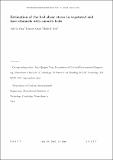Estimation of the bed shear stress in vegetated and bare channels with smooth beds
Author(s)
Yang, Judy Q.; Kerger, Francois; Nepf, Heidi
DownloadYang.Nepf_WRR_final_submitted.pdf (793.9Kb)
OPEN_ACCESS_POLICY
Open Access Policy
Creative Commons Attribution-Noncommercial-Share Alike
Terms of use
Metadata
Show full item recordAbstract
The shear stress at the bed of a channel influences important benthic processes such as sediment transport. Several methods exist to estimate the bed shear stress in bare channels without vegetation, but most of these are not appropriate for vegetated channels due to the impact of vegetation on the velocity profile and turbulence production. This study proposes a new model to estimate the bed shear stress in both vegetated and bare channels with smooth beds. The model, which is supported by measurements, indicates that for both bare and vegetated channels with smooth beds, within a viscous sublayer at the bed, the viscous stress decreases linearly with increasing distance from the bed, resulting in a parabolic velocity profile at the bed. For bare channels, the model describes the velocity profile in the overlap region of the Law of the Wall. For emergent canopies of sufficient density (frontal area per unit canopy volume α ≥ 4.3 m[superscript -1]), the thickness of the linear-stress layer is set by the stem diameter, leading to a simple estimate for bed shear stress.
Date issued
2015-05Department
Massachusetts Institute of Technology. Department of Civil and Environmental EngineeringJournal
Water Resources Research
Publisher
American Geophysical Union (Wiley platform)
Citation
Yang, Judy Q., Francois Kerger, and Heidi M. Nepf. “Estimation of the Bed Shear Stress in Vegetated and Bare Channels with Smooth Beds.” Water Resources Research (May 2015): n/a–n/a.
Version: Author's final manuscript
ISSN
00431397